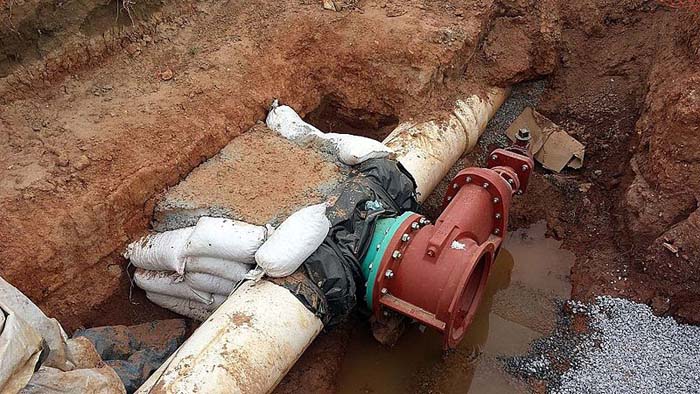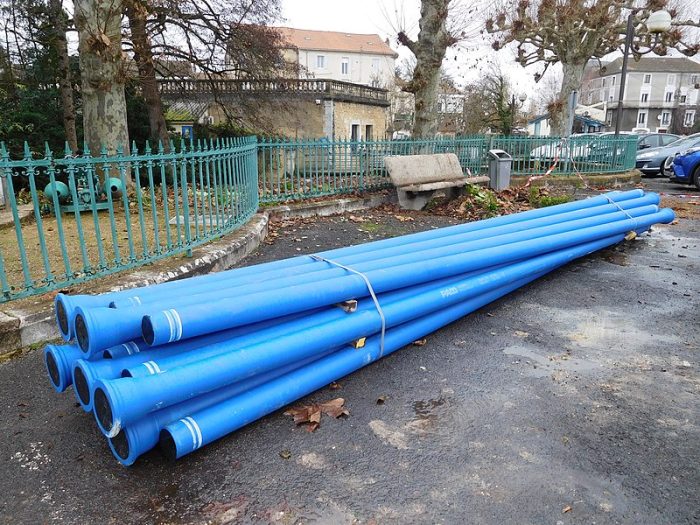
The primary function of water lines in a plumbing system is to carry water from the main water supply to different points of use in a structure. Hygiene and convenience are maintained in residential, commercial, and industrial environments through the delivery of clean, potable water and the disposal of effluent through these pipes.
Types of Water Lines
- Drainage Lines:
This transfers wastewater and enables sewage gases to be safely vented outdoors. They are also called drain-waste-vent (DWV) systems.
- ABS
They are popular with DWV systems because of their strength and simplicity of installation.
- Cast iron
Known for its long lifespan and soundproofing capabilities, it is commonly seen in older dwellings.
- PVC
Its low price and user-friendliness make it a popular choice for contemporary installations.
- Supply Lines:
This is the main line that supplies facilities like showers, toilets, and sinks with clean water. Here are some common materials:
- PVC
Because of its low price and ease of installation, it is primarily used for cold water.
- Copper
It is renowned for its long-lasting quality and ability to withstand corrosion.
- PEX
It is adaptable, simple to set up, and resistant to both chlorine and scale.
- CPVC
Just like PVC, it can also withstand hot water.
- Cold water lines
Plumbing fixtures like sinks, showers, toilets, and appliances rely on cold water lines, which carry the water from the main supply to these areas. These pipes are an essential component of any plumbing system because they carry potable water to every area that needs it.

Components of Cold Water Lines
- Fitting:
Various fittings, such as elbows, tees, and couplings, unite pipes and regulate water flow.
- Shut-Off Valves
Various valves are installed throughout the cold water lines to regulate water flow. This enables repairs and maintenance to be done without turning off the system entirely.
- Branch Lines
Miniature pipes transport water from the building’s main supply line to various rooms and appliances.
- Main supply line
The main line that carries water into the structure comes from either a public or private well.
How deep are the water lines buried?
Factors such as local building standards, climate, and unique geographical requirements might affect the depth at which water lines are buried. In general, these are the rules:
Soil Conditions and Terrain
The depth can also be influenced by the landscape and soil type. For example, it may be difficult to bury pipes particularly deeply in rocky regions; in such cases, other methods or more insulation may be required.
Standard Practice
In many regions, water lines are frequently laid at a depth of around 4 feet to keep them out of the way of surface activities and below the frost line.
Local Building Codes
The minimum depth for water lines is dictated by regional codes. To make sure you’re following the rules, you should contact the appropriate authorities in your area.
Frost Line Consideration
To avoid freezing, water pipes in colder regions must be buried below the frost line. The depth can vary from approximately 3 feet to more than 6 feet, depending on the severity of the winter.
Type of water line:
Subdivision or community main water lines may be buried deeper than individual home service connections.
Typical Depths
- Frost Line Consideration
It is critical to bury the lines below the frost line. In warmer climates, the frost line depth is around 20 inches, but in frigid places, it is over 6 feet.
- Irrigation Lines
They can be buried anywhere from six inches to two feet below ground, depending on the irrigation system and regional circumstances.
- Residential water supply lines
Placed typically at a depth of three to six feet (0.9 to 1.8 meters).
Steps for determining the depth
- Consult local building codes
For more detailed rules, contact your city hall.
- Determine Frost Line Depth
Determine the depth of the frost line in your region.
- Consider the Type of Water Line
Find out what the exact depth requirements are for the water line you’re installing.
- Evaluate Soil Conditions
Before deciding whether more depth or reinforcement is necessary, determine the soil type and stability.
Factors to consider when it comes to the depth of water lines
To make sure the system works well and safely, there are a lot of things to think about when deciding how deep the water lines should be. Some important factors to keep in mind are:
- Material Durability and Corrosion
- Protection Measures
Protecting the pipes with casings or coatings can make them last longer.
- Material Choice
When choosing corrosion-resistant materials, take into account the environmental and soil conditions.
- Soil conditions
- Soil Stability
Soils that aren’t stable can necessitate digging down or using more supports.
- Soil Type
When it comes to excavation and stability, different types of soil (e.g., loam, clay, and sand) have different characteristics.
- Code and Regulatory Requirements
- Environmental Regulations
Environmental consequences and standards are taken into account.
- Local building Codes
Local legislation and codes enforce adherence to minimum depth requirements.
- Hydraulic Considerations
- Connection Points
The location is perfect for making connections to main lines and distribution centers.
- Flow Rates
Effectively managing pressure and flow necessitates ensuring that the depth is sufficient.
- Safety
- Protection from Damage:
With deeper placement, the likelihood of unintentional harm caused by excavating or building operations decreases.
- Avoiding Pollution:
Ensuring the correct depth is crucial to avoiding surface pollution contamination.
- Natural features
- Water Table
Line placement may necessitate extra care in areas with high water tables.
- Terrain
The required depth may differ depending on elevation and slope variations.
- Load and Pressure
- Water Pressure:
A more stable water pressure can be achieved using deeper lines.
- Surface Load
Consider the possible effects of above-ground loads like buildings and cars on the underground cables.
- Future Expansion
- Scalability
Careful preparation for potential modifications or expansions in the coming years.
- Frost Line Depth
- Climate and weather conditions
To avoid freezing, water pipes in cold winter locations must be buried below the frost line. Different areas have different frost line depths.
- Installation and Maintenance
- Installation Cost
It may be more expensive to install trenches that are deeper.
- Ease of Access
Striking a balance between accessibility for maintenance and depth for protection.
An effective and dependable water distribution system is achievable by taking these considerations into account when deciding on the ideal depth for water lines. For every area-specific requirement, it is best to seek advice from specialists, engineers, and local authorities.
Installation and maintenance
- Planning and Design
A well-planned system will have its water lines laid out in a way that maximizes both the flow and pressure of water. ·
- Pipe routing, materials, and sizes need careful consideration.
- The Installation Process
From the primary supply line, work your way out to the distribution lines.
- Depending on the pipe material chosen, make sure you use the right fittings and methods.
- Verify that there are no leaks and that all connections are tight.
- Maintenance tips
- Removing mineral buildup and sediment from the system requires periodic flushing.
- In colder regions, insulating pipes can stop them from freezing.
- Checking for corrosion, leaks, and wear and tear on a regular basis.
Common Problems and Solutions
- Frozen pipes
- Using heat tape, maintaining a slow trickle, or insulating pipes are all viable options.
- Freezing and thawing of water inside pipes is a common occurrence in colder regions.
- Noisy pipes
- This is usually caused by loose pipes or a water hammer.
- Install water hammer arrestors, or use clamps to keep dangling pipes in place.
- Low water pressure
This can be caused by clogged, leaking, or inadequately sized pipes.
- Fix leaks, unclog pipes, or increase pipe diameters.
- Leaks
- As a result of broken pipes, corrosion, or loose connections.
- To fix, either use sealant, tighten fittings, or replace broken parts.
Conclusion
The distribution of water throughout a structure is made possible by water lines, which are an integral part of any plumbing system. Make sure your plumbing system is dependable and efficient by learning about the different materials, types, installation methods, and maintenance needs. Preventing typical problems and extending the life of the water lines is possible with regular examination and proactive maintenance.
When in doubt as to what depth is suitable, it is best to seek the advice of a licensed plumber or local building inspector.
